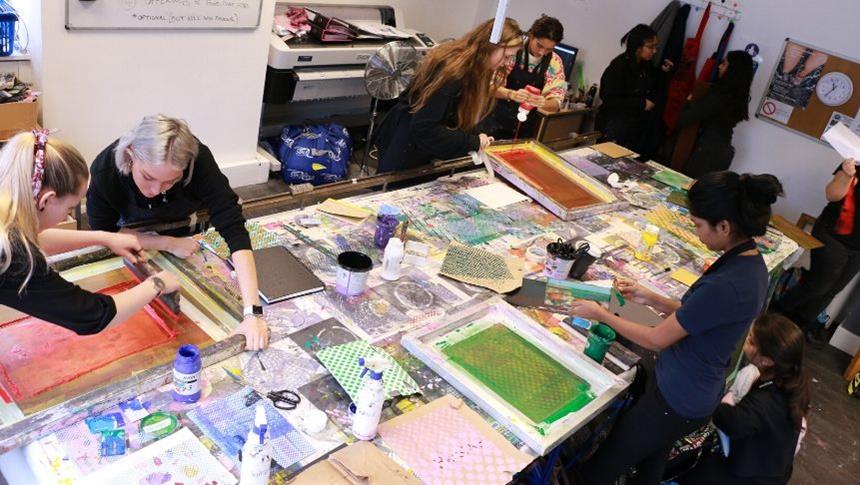Ever wondered where different fabrics with bright patterns and textures take form? Starting from within your own room to the grandest hotel, textiles have a huge impact in setting the tone of design. Textiles help make living spaces welcoming and inviting for visitors and can add a fancy touch to a boring room.
Fashion and textile design is about creating a cohesive and finished appearance that can convey sophistication, be it through clothing or interior design. If you want to learn about this specialised field of design and why you should take up a qualification in this field, continue reading.
What is a textile design?
Textile design involves using different processes and techniques to create constructed, digital and mixed media textiles. This is a creative field that involves forming the designs and then printing them onto various fabrics. This field also includes pattern-making and managing the production process for it.
Qualifications required to become a textile designer
The minimum academic qualification required to become a fashion and textile designer is a bachelor’s degree in this field. You must also be full of creativity and have a good eye for details.
Holding an undergraduate degree in textile design will provide students with a foundation in the creation and functional utility of various textiles. Graduates can also choose to continue their education and earn a master’s degree in this area in order to take up senior positions in managing textile design within an organisation.
Careers in fashion and textile design
A textile designer works with teams of designers and purchasing staff either for a design agency or as a freelancer. A good textiles designer will possess the ability to work collaboratively, meet deadlines and work well under pressure.
The following is a list of career options that are available in the fashion and textile industry:
- Clothing technologist (average annual salary: £32,500) – Clothing technologists work within the manufacturing and production industries and are typically involved in selecting and testing fabrics for products. These professionals work with a variety of materials including man-made and natural fibres, as well as leather, fur, metals and plastics.
Additionally, clothing technologists source textiles that are fit for purpose and carry out quality control tests. They liaise with those involved in the production process to carry out the development of products, improving production efficiency. Besides this, they are also responsible for responding to product queries, including complaints from wholesalers and customers.
- Fashion designer (average annual salary: £30,500) – Fashion designers specialise in using their technical knowledge and creative flair to work on designs for new and original clothing. They are required to stay up-to-date on the current fashion trends, forecasting what may be popular among consumers and taking inspiration from the industry to create fresh designs. They are proficient in analysing design from a technical perspective to plan and develop ranges, often based on a theme, or with emerging fashion trends. Furthermore, fashion designers are required to visit trade shows and manufacturers to source, select and buy fabrics, trims, fastenings and embellishments.
- Colour technologist (average annual salary: £29,500) – Colour technologists typically have an enquiring mind and enjoy working with the science and technology of colour application and its subsequent outcomes. These professionals can find employment in various sectors of the manufacturing industry, where they work to produce dyes and pigments for a whole range of products, such as cosmetics, food colouring or furnishings. Colour technologists liaise with both suppliers and end-users, to carry out this analytical role. In addition to developing new dyes and pigments to provide specific colours, they also ensure that the reproduction of products is accurate, application is even and the colour has durability.
- Textile designer (average annual salary: £21,117) – Textile designers create two-dimensional designs by using colour, texture, fabric and pattern. They typically specialise in two major areas of textiles - interiors and fabrics for clothing. Besides producing sketches, designs and samples for customers, textile designers are also expected to collaborate with clients and technical, marketing and buying staff to plan and develop designs. They are highly-proficient in accurately interpreting and representing clients' idea and possess up-to-date knowledge of new design and production techniques and textile technology. Furthermore, they are also known for using specialist software and computer-aided design (CAD) programmes to develop a range of designs.
London College of Contemporary Arts (LCCA) offers a wide range of programmes on fashion and textile design that can help you become a knowledgeable professional in the field of textiles and land lucrative positions in this field. Feeling curious and want to learn how different processes can result in distinct weaves and textures? Go ahead and apply for our HNC/ HND in Fashion and Textiles programme today to obtain unique design skills that will set you apart from the crowd!
This article was written by Deblina Dam and edited by Anisa C.

